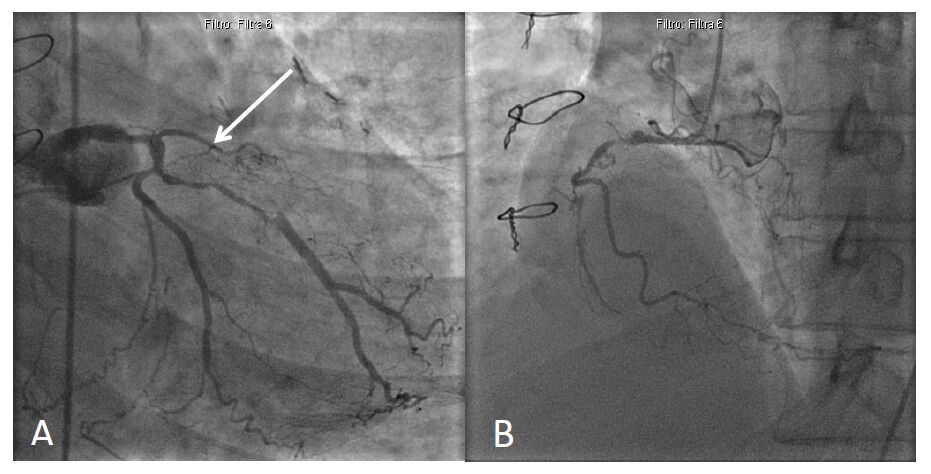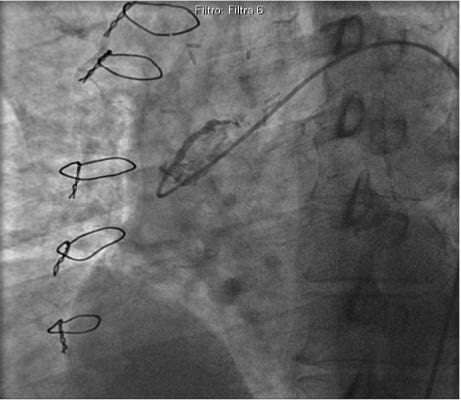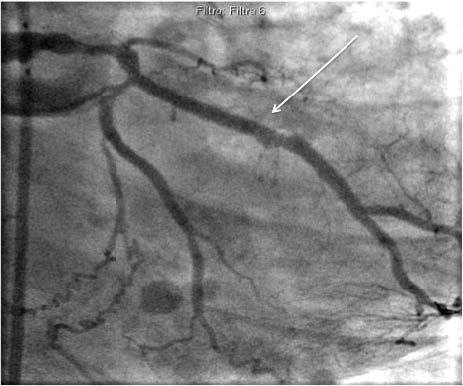We describe a case of a patient with a clinical history of coronary artery disease, previously treated by coronary surgery and, one year later, by percutaneous coronary intervention plus stenting for sub-occlusive disease of the saphenous vein graft to first obtuse marginal (OM) branch. The patient, admitted to our emergency room with chest pain, nausea, hypotension and diaphoresis, had elevated blood levels of cardiac troponin T and EKG showed elevation of the ST segment in the in lateral leads, suggesting a diagnosis of ST elevated myocardial infarction (STEMI). Thus, coronary angiography was immediately performed, showing the massive thrombosis of the saphenous vein graft previously treated by stenting and the slight patency of the native vessel. We decided to approach the native vessel instead of clashing to the massive thrombus of the saphenous vein graft, overcoming the actual guidelines indications.
Citation: Marco Ferrone, Anna Franzone, Bruno Trimarco, Giovanni Esposito, Plinio Cirillo. Percutaneous Coronary Intervention in a Patient with Acute Thrombosis of Saphenous Vein Graft and Patent Native Coronary Artery: Which is the Vessel to Approach?[J]. AIMS Medical Science, 2015, 2(4): 310-315. doi: 10.3934/medsci.2015.4.310
Related Papers:
| [1] |
Pasquale Marcello Falcone .
Editorial to the 'Special Issue—Energy transition in a circular economy perspective' of AIMS Energy. AIMS Energy, 2022, 10(4): 582-584.
doi: 10.3934/energy.2022029
|
| [2] |
Mamdouh El Haj Assad, Siamak Hoseinzadeh .
Editorial to the 'Special Issue-Analyzing energy storage systems for the applications of renewable energy sources' of AIMS Energy. AIMS Energy, 2022, 10(5): 1074-1076.
doi: 10.3934/energy.2022050
|
| [3] |
Santi Agatino Rizzo .
Editorial to the 'Special Issue—Distribution network reliability in Smart Grids and Microgrids' of AIMS Energy. AIMS Energy, 2022, 10(3): 533-534.
doi: 10.3934/energy.2022026
|
| [4] |
Abshir Ashour, Taib Iskandar Mohamad, Kamaruzzaman Sopian, Norasikin Ahmad Ludin, Khaled Alzahrani, Adnan Ibrahim .
Performance optimization of a photovoltaic-diesel hybrid power system for Yanbu, Saudi Arabia. AIMS Energy, 2021, 9(6): 1260-1273.
doi: 10.3934/energy.2021058
|
| [5] |
Jin H. Jo, Kadi Ilves, Tyler Barth, Ellen Leszczynski .
Correction: Implementation of a large-scale solar photovoltaic system at a higher education institution in Illinois, USA. AIMS Energy, 2017, 5(2): 313-315.
doi: 10.3934/energy.2017.2.313
|
| [6] |
Jin H. Jo, Zachary Rose, Jamie Cross, Evan Daebel, Andrew Verderber, John C. Kostelnick .
Application of Airborne LiDAR Data and Geographic Information Systems (GIS) to Develop a Distributed Generation System for the Town of Normal, IL. AIMS Energy, 2015, 3(2): 173-183.
doi: 10.3934/energy.2015.2.173
|
| [7] |
Taihana Paula, Maria de Fatima Marques .
Recent advances in polymer structures for organic solar cells: A review. AIMS Energy, 2022, 10(1): 149-176.
doi: 10.3934/energy.2022009
|
| [8] |
Peter Majewski, Rong Deng, Pablo R Dias, Megan Jones .
Product stewardship considerations for solar photovoltaic panels. AIMS Energy, 2023, 11(1): 140-155.
doi: 10.3934/energy.2023008
|
| [9] |
Sabir Rustemli, Zeki İlcihan, Gökhan Sahin, Wilfried G. J. H. M. van Sark .
A novel design and simulation of a mechanical coordinate based photovoltaic solar tracking system. AIMS Energy, 2023, 11(5): 753-773.
doi: 10.3934/energy.2023037
|
| [10] |
Md. Mehadi Hasan Shamim, Sidratul Montaha Silmee, Md. Mamun Sikder .
Optimization and cost-benefit analysis of a grid-connected solar photovoltaic system. AIMS Energy, 2022, 10(3): 434-457.
doi: 10.3934/energy.2022022
|
Abstract
We describe a case of a patient with a clinical history of coronary artery disease, previously treated by coronary surgery and, one year later, by percutaneous coronary intervention plus stenting for sub-occlusive disease of the saphenous vein graft to first obtuse marginal (OM) branch. The patient, admitted to our emergency room with chest pain, nausea, hypotension and diaphoresis, had elevated blood levels of cardiac troponin T and EKG showed elevation of the ST segment in the in lateral leads, suggesting a diagnosis of ST elevated myocardial infarction (STEMI). Thus, coronary angiography was immediately performed, showing the massive thrombosis of the saphenous vein graft previously treated by stenting and the slight patency of the native vessel. We decided to approach the native vessel instead of clashing to the massive thrombus of the saphenous vein graft, overcoming the actual guidelines indications.
In most of the countries, the solar photovoltaic systems have reached to the grid parity. The higher capacity of solar photovoltaic power plants are connecting within the higher and medium voltage networks, and lower capacity photovoltaic units within the low voltage network (i.e., distributed network). There are many technical challenges for integrating the solar PV plants at higher voltage levels as well as lower voltage levels. The key challenging issues, for increasing further penetration of solar photovoltaic systems in the electrical power network, are technology developments for intelligent power conditioning devices, integration of hybrid energy storage for making solar photovoltaic system as dispatchable power source, mitigation of power quality issues, demand side management, technology development of solar photovoltaic based micro-grid, techno-economic operational strategies, etc.
The solar photovoltaic system engineering depends on many factors (e.g., techno-economic sizing, energy management, energy dispatch strategies, resources allocations etc.). Different geographical locations as well as climatic conditions also influence the operation and performance of the solar photovoltaic-based system. The incident solar radiation has significant impact on the solar photovoltaic system energy production. The solar photovoltaic system energy output is influenced by the geometrical configuration of photovoltaic array and the view factor to sky effect. In the recent years, there are many technical innovations, developments have happened for deployments of solar photovoltaic system grid integration with energy storage for participating either as an active generator or operating as a solar photovoltaic based micro-grid. Within the distributed energy network, solar photovoltaic systems can also be used as ‘building integrated photovoltaic systems (BIPV)’ to provide electrical energy locally and make the buildings as ‘zero energy buildings (ZEBs)’. In future, ZEBs are going to play a significant role in the upcoming smart distributed energy network development due to their contribution of on-site electrical generation through solar photovoltaic systems, energy storage, demand side management etc. In order to increase further PV penetration within the distribution network and develop innovative mitigation techniques, there is critical need of further field-oriented research in the above-mentioned topics.
This Special Issue of AIMS Energy Journal comprises peer-review articles on advancement of power dispatching techniques for solar photovoltaic system with energy storage, shading and diffused solar radiation effects on the performance of solar photovoltaic system, intelligent controllers for distributed energy resources allocations, material characterization for heterojunction solar cells. In addition, some articles cover the typical case studies of solar photovoltaic systems in the tropical region.
As the Guest Editor of this Special Issue ‘Solar Photovoltaic System Engineering’ of the AIMS Energy Journal, I express my sincere appreciation to the journal editorial team, authors and reviewers of the manuscripts, journal editorial supporting team, and all those who have contributed and supported in successful fruition and publication.
Professor Mohan Lal Kolhe
Professor in Smart Grid and Renewable Energy
Faculty of Engineering and Science,
University of Agder,
PO Box 422, NO 4604, Kristiansand, Norway
www.uia.no
E-mail: Mohan.L.Kolhe@uia.no
References
|
[1]
|
Yap CH, Sposato L, Akowuah E, et al. (2009) Contemporary results show repeat coronary artery bypass grafting remains a risk factor for operative mortality. Ann Thorac Surg 87(5): 1386-1391.
|
|
[2]
|
Sarwar B, Brener SJ (2014) Saphenous vein graft interventions. Curr Treat Options Cardiovasc Med 16(5): 301.
|
|
[3]
|
Brilakis ES, Lichtenwalter C, Abdel-karim AR, et al. (2011) Continued benefit from paclitaxel-eluting compared with bare-metal stent implantation in saphenous vein graft lesions during long-term follow-up of the SOS (Stenting of Saphenous Vein Grafts) trial. JACC Cardiovasc Interv 4(2): 176-182.
|
|
[4]
|
Xanthopoulou I, Davlouros P, Tsigkas G, et al. (2011) Long-term clinical outcome after percutaneous coronary intervention in grafts vs native vessels in patients with previous coronary artery bypass grafting. Can J Cardiol 27(6): 716-724.
|
|
[5]
|
Hoffmann R, Nitendo G, Deserno V, et al. (2010) Follow-up results after interventional treatment of infarct-related saphenous vein graft occlusion. Coron Artery Dis 21(2): 61-64.
|
|
[6]
|
Yeh RW, Sidney S, Chandra M, et al. (2010) Population trends in the incidence and outcomes of acute myocardial infarction. N Engl J Med 362(23): 2155-2165.
|
|
[7]
|
Abdel-Karim AR, Banerjee S, Brilakis ES (2010) Percutaneous intervention of acutely occluded saphenous vein grafts: contemporary techniques and outcomes. J Invasive Cardiol 22(6): 253-257.
|
|
[8]
|
Gaglia MA, Torguson R, Xue Z, et al. (2011) Outcomes of patients with acute myocardial infarction from a saphenous vein graft culprit undergoing percutaneous coronary intervention. Catheter Cardiovasc Interv 78(1): 23-29.
|
|
[9]
|
Mehilli J, Pache J, Abdel-Wahab M, et al. (2011) Drug-eluting versus bare-metal stents in saphenous vein graft lesions (ISAR-CABG): a randomised controlled superiority trial. Lancet 378(9796): 1071-1078.
|
|
[10]
|
Vermeersch P, Agostoni P, Verheye S, et al. (2007) Increased late mortality after sirolimus-eluting stents versus bare-metal stents in diseased saphenous vein grafts: results from the randomized DELAYED RRISC Trial. J Am Coll Cardiol 50(3): 261-267.
|
|
[11]
|
Costopoulos C, Latib A, Naganuma T, et al. (2013) Comparison of first- and second-generation drug-eluting stents in saphenous vein grafts used as aorto-coronary conduits. Am J Cardiol 112(3): 318-322.
|
|
[12]
|
Taniwaki M, Räber L, Magro M, et al. (2014) Long-term comparison of everolimus-eluting stents with sirolimus- and paclitaxel-eluting stents for percutaneous coronary intervention of saphenous vein grafts. EuroIntervention 9(12): 1432-1434.
|
|
[13]
|
Kitabata H, Loh JP, Pendyala LK, et al. (2013) Two-year follow-up of outcomes of second-generation everolimus-eluting stents versus first-generation drug-eluting stents for stenosis of saphenous vein grafts used as aortocoronary conduits. Am J Cardiol 112(1): 61-67.
|















 DownLoad:
DownLoad: